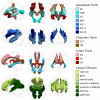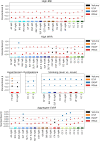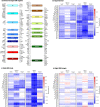Topography of associations between cardiovascular risk factors and myelin loss in the ageing human brain
- PMID: 37037939
- PMCID: PMC10086032
- DOI: 10.1038/s42003-023-04741-1
Topography of associations between cardiovascular risk factors and myelin loss in the ageing human brain
Abstract
Our knowledge of the mechanisms underlying the vulnerability of the brain's white matter microstructure to cardiovascular risk factors (CVRFs) is still limited. We used a quantitative magnetic resonance imaging (MRI) protocol in a single centre setting to investigate the cross-sectional association between CVRFs and brain tissue properties of white matter tracts in a large community-dwelling cohort (n = 1104, age range 46-87 years). Arterial hypertension was associated with lower myelin and axonal density MRI indices, paralleled by higher extracellular water content. Obesity showed similar associations, though with myelin difference only in male participants. Associations between CVRFs and white matter microstructure were observed predominantly in limbic and prefrontal tracts. Additional genetic, lifestyle and psychiatric factors did not modulate these results, but moderate-to-vigorous physical activity was linked to higher myelin content independently of CVRFs. Our findings complement previously described CVRF-related changes in brain water diffusion properties pointing towards myelin loss and neuroinflammation rather than neurodegeneration.
© 2023. The Author(s).
Conflict of interest statement
The authors declare no competing interests.
Figures






Similar articles
-
Converging patterns of aging-associated brain volume loss and tissue microstructure differences.Neurobiol Aging. 2020 Apr;88:108-118. doi: 10.1016/j.neurobiolaging.2020.01.006. Epub 2020 Jan 15. Neurobiol Aging. 2020. PMID: 32035845
-
Myelin Water Fraction Imaging of the Brain in Children with Prenatal Alcohol Exposure.Alcohol Clin Exp Res. 2019 May;43(5):833-841. doi: 10.1111/acer.14024. Epub 2019 Apr 8. Alcohol Clin Exp Res. 2019. PMID: 30889291
-
Alterations of Myelin Content in Parkinson's Disease: A Cross-Sectional Neuroimaging Study.PLoS One. 2016 Oct 5;11(10):e0163774. doi: 10.1371/journal.pone.0163774. eCollection 2016. PLoS One. 2016. PMID: 27706215 Free PMC article.
-
Association of Amyloid Pathology With Myelin Alteration in Preclinical Alzheimer Disease.JAMA Neurol. 2017 Jan 1;74(1):41-49. doi: 10.1001/jamaneurol.2016.3232. JAMA Neurol. 2017. PMID: 27842175 Free PMC article.
-
White matter involvement after TBI: Clues to axon and myelin repair capacity.Exp Neurol. 2016 Jan;275 Pt 3:328-333. doi: 10.1016/j.expneurol.2015.02.011. Epub 2015 Feb 16. Exp Neurol. 2016. PMID: 25697845 Review.
Cited by
-
Associations between APOE-TOMM40 '523 haplotypes and limbic system white matter microstructure.Alzheimers Dement (Amst). 2025 Apr 6;17(2):e70099. doi: 10.1002/dad2.70099. eCollection 2025 Apr-Jun. Alzheimers Dement (Amst). 2025. PMID: 40201595 Free PMC article.
-
Enduring differential patterns of neuronal loss and myelination along 6-month pulsatile gonadotropin-releasing hormone therapy in individuals with Down syndrome.Brain Commun. 2025 Mar 22;7(2):fcaf117. doi: 10.1093/braincomms/fcaf117. eCollection 2025. Brain Commun. 2025. PMID: 40190351 Free PMC article.
-
EBNA-1 and VCA-p18 immunoglobulin markers link Epstein-Barr virus immune response and brain's myelin content to fatigue in a community-dwelling cohort.Brain Behav Immun Health. 2024 Nov 9;42:100896. doi: 10.1016/j.bbih.2024.100896. eCollection 2024 Dec. Brain Behav Immun Health. 2024. PMID: 39624483 Free PMC article.
-
Stratifying vascular disease patients into homogeneous subgroups using machine learning and FLAIR MRI biomarkers.Npj Imaging. 2024;2(1):56. doi: 10.1038/s44303-024-00063-x. Epub 2024 Dec 31. Npj Imaging. 2024. PMID: 39749287 Free PMC article.
-
The Neurobiology of Life Course Socioeconomic Conditions and Associated Cognitive Performance in Middle to Late Adulthood.J Neurosci. 2024 Apr 24;44(17):e1231232024. doi: 10.1523/JNEUROSCI.1231-23.2024. J Neurosci. 2024. PMID: 38499361 Free PMC article.
References
Publication types
MeSH terms
Substances
LinkOut - more resources
Full Text Sources

